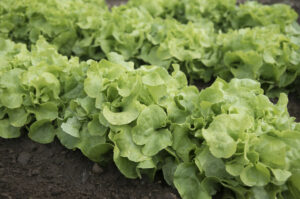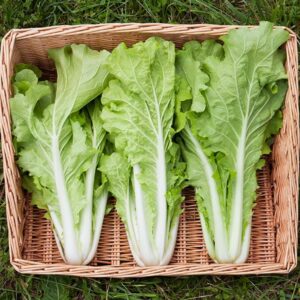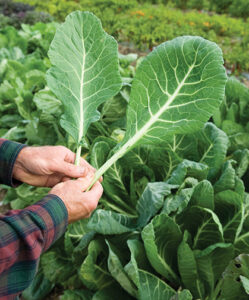By Richard Robinson, Farmer at Hopestill Farm
Tokyo Bekana, collards, and Panisse lettuce were the standout new additions to my garden in 2020. I’m looking forward to growing more, and selling more, of each this season.
One of the many pleasures of keeping a big garden is the opportunity to try new crops each year. Because tomatoes and lettuce are the two most popular offerings in our CSA’s and the two biggest money makers at our virtual farmstand, I am especially eager to try new varieties of each, hoping to improve the harvest a bit more every year.

Panisse lettuce. Photo courtesy Johnny’s Selected Seeds.
In 2020, I didn’t find any great new tomato variety, but I did find a real keeper in the lettuce department: Panisse. It is a green oakleaf, but the leaves are more luxurious and a bit softer than most other oakleaves, more like a deeply cut Bibb. It grows very rapidly, quickly outpacing almost any other variety, and holds a long time without bolting or bitterness, even in the middle of summer. And, its taste is superb. Like other oakleaves (and Bibbs), its biggest leaves are the lowest ones, and get a bit dirty spread out on the soil, so plan to wash or trim before sale or salad. Thanks to Derek Christiansen who recommended this variety at the 2020 NOFA/Mass Winter Conference.
Two other new crops, that I was not expecting much from, turned out to be huge hits last year. Both are crucifers.

Tokyo Benaka. Photo courtesy High Mowing Organic Seeds.
Tokyo Bekana is a mild mustardy green; I like to tell my customers it is mild enough for salad, and strong enough for stir fry. It grows tall (up to 2 feet if you let it, but that’s too much food for most people), with leaves that have a large but tender midrib. Like a Napa cabbage, the midribs form a dense center. But unlike Napa, the leaves stay loose, not forming a tight head. Tokyo Bekana can be grown as a cut-and-come-again crop. If you want it to, be sure to cut at least half an inch above the root-shoot connection; if you cut the root, it won’t regrow (I figured that out about two-thirds of the way through the season…). This year I’ll be experimenting with multiple re-cutting, to see how many times it can be harvested while maintaining flavor and tenderness. Tokyo Bekana also appears to be astonishingly cold-hardy. I haven’t been through a full winter with it yet, but plants I transplanted into an unheated hoop house in late September are still looking great in mid-February, despite lots of nights in the teens and some in the single digits.
Finally, I am excited to expand my production of collards, which I grew for the first time last year. It’s possible I’m just late to this party, but I have not been aware that collards have made their way into many northern gardens. I hope that changes—this fast-growing broccoli relative bears large leaves that, with midrib removed, cook up tender, with a taste that is deep and rich and earthy. While you can cook them with animal fat, there is no reason you need to—just steam them up in a microwave for a real treat. Despite their association with the South, collards are quite cold hardy; I was harvesting into November last year, just as long as kale. And my customers couldn’t get enough of them. I’ll be trying to keep up with demand this year by starting early and planting lots. If you haven’t tried them before, I hope you’ll consider making room for collards this year.

Collard Greens. Photo courtesy Johnny’s Selected Seeds.
Read more from Richard Robinson in the NOFA/Mass newsletter archives.





